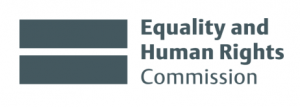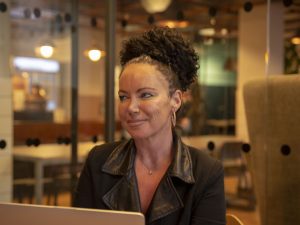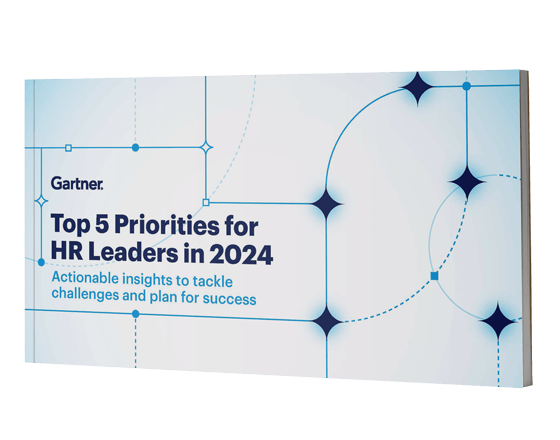Equality, Diversity & Inclusion Explained
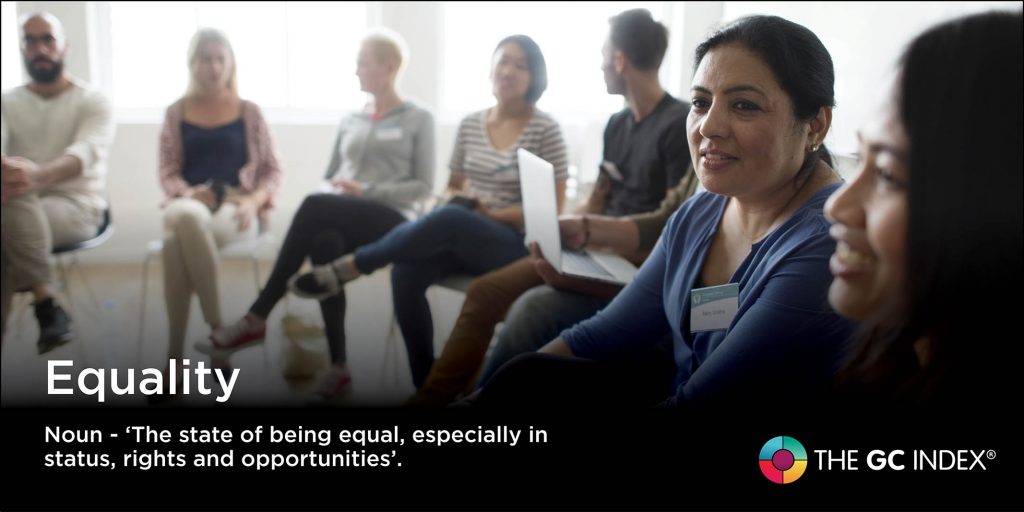
Equality
Noun – ‘The state of being equal, especially in status, rights and opportunities’.
Definition of equality –
‘Equality is about ensuring that every individual has an equal opportunity to make the most of their lives and talents. It is also the belief that no one should have poorer life chances because of the way they were born, where they came from, what they believe, or whether they have a disability’ – Equality and Human Rights Commission.
If we look back through history we’ll see endless examples of individuals who have experienced discrimination based on protected characteristics such as race, disability, sex and sexual orientation.
How do we currently manage Equality?
We are often asked, ‘what is equality?’ Starting in the 1970’s a number of acts of parliament were passed to protect everyone from discrimination on the grounds of their protected characteristcs. All of these acts of parliament were then combined in 2010 to become The Equality Act 2010.
In it’s essence The Equality Act 2010 prevents organisations as employers, education and service providers from discriminating against individuals protected characteristics.
What is an example of equality?
So how do we define equality? If we apply the equality meaning to opportunities, then it follows that all should be made available to everyone. Selection procedures should be fair and impartial. When organisations are advertising vacancies, they must not just assume that their usual processes are inclusive or equal.
People must not be treated unfairly because of reasons protected by the law of discrimination i.e. age, race or sex. Some companies are so alert to this that they deliberately hide this personal information on application forms, only making it known once through to the interview stage. Equality can only exist if everyone starts at the same point.
Why are equality and diversity important?
If we look at the equality definition, then no matter the business sector, equality and diversity are important for all types of workplaces. Whether you employ just a couple of people or hundreds, everyone must have access to the same opportunities. They must all be treated in the same fair way. This helps eliminate bullying, victimisation, harassment and discrimination. There must be no hidden barriers that affect only a few. Businesses that have a solid equality and diversity policy will thrive, with people from all backgrounds being able to succeed.
Understanding equality and diversity
Equality and diversity exist to promote equality of opportunity for everyone via diversity, giving each the chance to achieve their full potential free from any discrimination. But what is classed as discrimination? In the UK, not only the Equality Act but also many others help provide equal opportunity and prevent discrimination i.e. Sex Discrimination Act, Disability Discrimination Act, Race Relations Act and the Human Rights Act.
Equal opportunity means that all people should be treated the same, without judgement. Organisations that appreciate and understand the different skills available within its workforce can become employers of choice. Legislation exists to ensure that all job opportunities comply with strict guidelines concerning equality.
By tapping into the power of a diverse workforce, organisations can soon build a competitive edge and need to have an equal opportunities policy. This not only protects employees but also ensures that employers don’t break any laws:
- Both male and female workers are paid the same wage for doing the same job
- Physical disabilities do not prevent staff from carrying out their role
- Age is not used as a barrier where the employee has the necessary skills
- Promotion is not overlooked due to disability, gender or sexuality
Equality applies to both employer and employee in that both can fall foul of the law if they discriminate.
By promoting equality and diversity, organisations can benefit in many ways. Employees from other cultures or countries can help with communication and marketing to a wider range of customers, ensuring that they are both appropriate and sensitive.
As values are shared amongst workers, aspects of fairness, respect and tolerance are promoted. The working environment will become more balanced, with flexible working hours or even remote working from home. Research shows that when employed within a diverse working environment, employee performance is boosted. People feel appreciated rather than constrained, understanding that they will not miss out on promotion due to gender, race or disability. Individual progress is based upon ability and not stereotypical demographics.
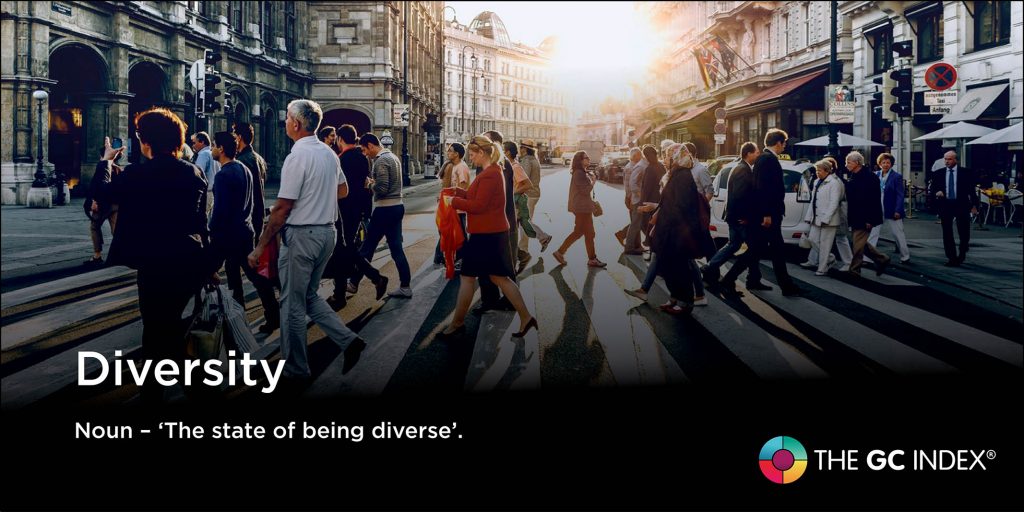
Diversity
Noun – ‘The state of being diverse’.
The diversity definition means more than just acknowledging and tolerating differences. To truly practice Diversity we need to:
- Build alliances across differences so that we can work together to eradicate all forms of discrimination.
- Practice mutual respect for an individuals proclivities and experiences that are different from our own
- Understand that diversity includes not only ways of being but also ways of knowing
- Recognising that personal, cultural and institutionalised discrimination creates and sustains privileges for some while creating and sustaining disadvantages for others
- Understand and appreciate interdependence of humanity, cultures, and the natural environment
We all, as individuals, bring a diverse set of energies, perspectives, work and life experiences, as well as religious and cultural differences.
By recognising these differences and understanding ‘what does diversity mean?’ we can learn to respect and value each individual, unlocking and benefitting from the rewards. This is the definition of diversity.
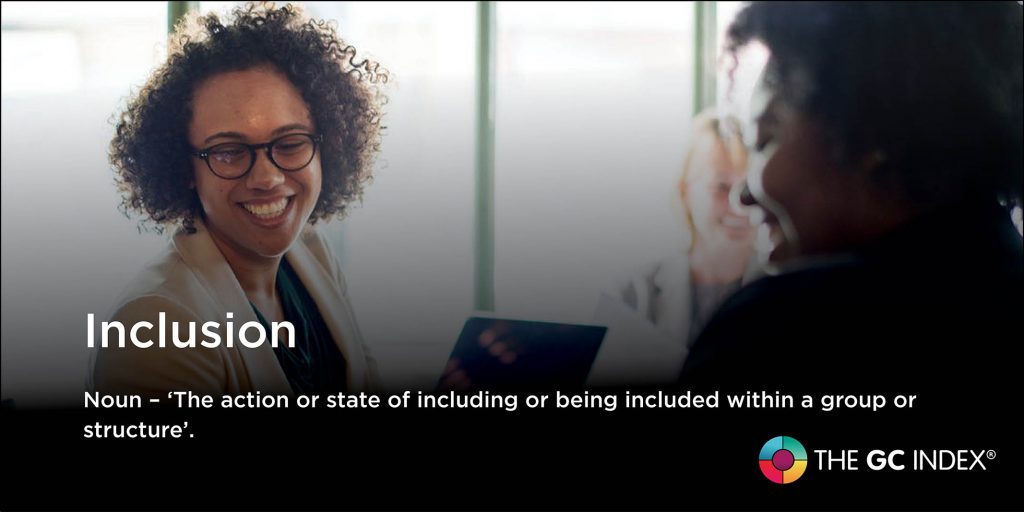
Inclusion
Noun – ‘The action or state of including or being included within a group or structure’.
Inclusion is not a one-way street. It works two ways. Organisations need to make sure they instil an inclusive culture facilitating people to proactively engage. Feeling included is a sense of being a part of a community or organisation.
We now live in an era where innovation is the driving force behind beating the competitor and organisations now understand that they need to attract the best talent to succeed. Now we understand what Equality, Diversity and Inclusion mean where do we start in terms of ensuring that we as individuals as well as our organisations start to live by their meanings and reap the benefits?
Vicky Sleight, CEO and GCologist, at GC Partner The Perfect Ltd, says:
“Companies are now starting to wake up to the fact that in order to be innovative, and competitive they need to attract the best talent. To do that the environment needs to be set up with an inclusive culture, one that allows everyone to reach their full potential.”
Research from the likes of McKinsey tells us that:
‘Diverse and inclusive teams are not just more innovative, companies in the top quartile for gender or racial and ethnic diversity are more likely to have financial returns above their national industry medians. Companies in the bottom quartile in these dimensions are statistically less likely to achieve above-average returns. And diversity is probably a competitive differentiator that shifts market share toward more diverse companies over time.’
Diversity is more than just about gender. Creating environments where different voices are not only heard, but encouraged is, today, becoming even more significant.
These voices may come from people who are not of the same gender, ethnicity or race Diversity in the workplace includes:
- Sexual orientation
- Disability
- Socio economic background
- Religious affiliation
- Gender
- Ethnicity
- Generation
- Thinking style
The new way of thinking is more about the individual rather than the HR initiative. It needs to be taken into the wider business strategy, to become the innovation strategy and not just a tick in the box.
It has become very important to build an environment where every individual can bring their whole self to work and to encourage them to draw upon their own unique experiences, thoughts and perspectives to help deliver business goals to and to build products and services that reflect the full markets organisations are trying to serve.
What is an example of inclusion?
So what do you mean by inclusion? Let’s look at a general example of inclusion in practice that will help us understand the ‘inclusion meaning’ from Apple:
“At Apple, we’re not all the same. And that’s our greatest strength. We draw on the differences in who we are, what we’ve experienced, and how we think. Because to create products that serve everyone, we believe in including everyone.”
This is Apple’s diversity and inclusion policy. If we look at the inclusivity meaning in this statement provided by Apple, we can identify the key wording. In large letters, we see the words ‘Different together’. This jumps out from the page, giving the reader a clear understanding of what is being said. Short sentences have been used, easily readable by anyone. There are no complex phrases or words. Instead, the focus is on diversity in the form of employees, products and customers. Not only does the content clearly define inclusivity but it has also been written in an inclusive way. Apple score in every direction.
What is meant by inclusion and inclusive practices?
The aim of inclusion, or inclusive practices, is to include everyone, no matter their sexual orientation, culture, religion, race, age, gender or disability. It puts everyone onto a level playing field, knocking down any barriers and obliterating intolerance or discrimination. Companies that have inclusive policies do all possible to make all staff feel included and a part of the team, no matter their role.
To make a working environment fully inclusive, everyone should work together as a part of the team. Those that have issues, such as a disability, will be treated the same as everyone else, with the same opportunities for growth and progression. By being responsive to workers’ needs, the operation can build a name for itself as an inclusive organisation. Respect is very high on the list, with everyone being recognised for what they bring to the company, no matter their culture or background. By creating a tolerant and understanding setting, people can flourish, feeling accepted for who they are. When everyone feels equally valued, any issues are easily resolved out in the open.
Businesses need to do the following to promote inclusivity:
- Acknowledge the fact that people come from a variety of backgrounds
- Avoid the use of stereotypes that alienate people
- Encourage an environment that is open to the acceptance of different perspectives
- Treat everyone as an individual
- Build good rapport between management and staff
- Remove biases about people from other cultures and backgrounds, both conscious and unconscious
So what are some of the actions that a company should take to build inclusive work places that work for all?
Build an inclusive corporate culture where these different voices can be heard. Educate your leaders and celebrate employee differences. Remember what gets measured gets done, so goals need to be communicated and progress measured.
Commit with purpose and cascade. What does inclusion look like in your organisation. Communicate the what, the how and the why and engage and educate all employees on the purpose.
Change the meetings. If the same people are in the same room all the time – you will always get the same outcomes. Include a diverse group of people in the meetings and inspire new approaches and ideas.
And we need to engage men. When we strive for equality it is not about taking a slice from one person to give to another. Diversity is not a pie. Men can help to advocate real change and there are many excellent role models. Take Marc Benioff at Salesforce who assessed the gender pay gap across the company and then implemented the correction and change.
So leadership does of course matter and every single leader should model inclusive behaviour. We need to acknowledge the biases because we all have them whether conscious or unconscious. If they are acknowledged then the behavioural tendencies can be recognised and changes put in place.
Diversity is a mentality and not just a strategic imperative. It is a cultural movement and although it cannot be measured in the same way as most business metrics the key is in keeping the momentum going every day. As Neil Lenane tells us, ‘If you do not intentionally include, you unintentionally exclude”.

GCologist and GC Partner Lee Lam, CEO of Lee Lam Consulting, believes the ‘Diversity Challenge’ has deeper roots.
The challenge of getting a more diverse and inclusive workforce usually begins by asking how the playing field can be levelled, so that female employees get equal opportunities and comparable pay to their male counterparts. But this thinking makes a huge assumption and one that ultimately, takes us on the wrong path. It assumes that the ‘male counterparts’ are in an optimal position, where their working environment is as good as it can be. But thanks to employee surveys, Glassdoor reviews and employee engagement insights, we know that there is still a lot wrong with the current situation and so that begs the question – do we really want to give women the same experience?
The current people management strategies are systemically flawed – they continue to use lazy definitions of what is ‘fair’ and ‘equitable’ to the point where even those who are supposed to benefit most from the systems rarely do so.
Recruitment is the first main area that needs to be redefined – it is believed that the fairest way of finding and hiring talent is to cast your net as wide as possible, but this in turn creates the problem of having way too many candidates. From there, you follow a process of filtration and elimination based on the flimsiest of reasons – lack of certain keywords, too many pages on the CV, random luck of which ones get picked, gaps on the career history. This last one negatively impacts women to a large degree, who will have a clear gap on their history during periods of maternity leave and bringing up their children. In this format, the CV can never be truly ‘blind’ because things such as those listed above will be unconsciously and instinctively seen by hiring managers and will affect their decision, with all the best intentions in play.
None of the above examples of sorting through the applicants allow you to truly find the people who are going to bring the most value and future profitability to your organisation because in reality, the pool that has been used is far too broad and deep and the best you can hope for is to find someone who sort of fits the profile you are looking for in the small sample you skim from the long list of applicants, simply because there is no way to adequately assess every single applicant. If you receive 1000 applications, after the keyword searches and filtering is done, you may still have several hundred CVs that match all of your requirements, but the likelihood is that you are only reading and assessing a tiny proportion of that, maybe 20-30 CVs. In that smaller group, unless one of your search criteria is for women, the likelihood of you selecting a diverse group of candidates is extremely rare.
Your search and filtering criteria may also have a major design fault – you are searching for the same characteristics as the people who already work in your organisation … and so you get similar type of people. It might sound obvious, but if certain demographics are the majority in a workplace, then it is likely that you are going to inadvertently search for the same people – and then wonder why you are not attracting diverse talent.
For example, a 2018 study showed that the number of female law partners had not increased in the last 12 years and many organisations then began to try to attract female talent into senior positions. However, the criteria used included needing experience at senior level of several years, because that is what the (male) partners had to demonstrate for their progression to Partner. In this vicious cycle, there is an obvious problem – how can women break into senior roles for the first time if the pre-requisite is that they have done it before?
A broader point is that companies are focused on bringing in or developing more innovation and creativity, and yet because of this need for significant experience, end up hiring the people who have been in the industry for a long time, and who are used to the status quo. Whilst you may find the odd person able to think more innovatively, disruptors in every industry are showing that the real power comes from a lack of experience which allows you to ask the more basic questions that have stopped being asked. If you are only fishing in the same pond time and time again, eventually, you are going to stop catching any new fish and with it, potential new ideas.
If you are fortunate enough to attract in a diverse range of people to join your organisation, how do you keep them engaged and performing? There are some fantastic initiatives designed to help support diverse demographics, but they are usually managed as a separate workstream from the general employee engagement and talent management strategies. This leads to a lack of cohesion in goals, objectives and strategies, and it can lead to the assumption that the overall working environment simply needs a few tweaks, but diversity and inclusion requires a different focus and approach. Whilst there are obviously concerns that are specific to those demographics, it is also obvious that many people outside those groups also feel unhappy, disempowered and quite their jobs. The ‘otherness’ created by a separate diversity and inclusion strategy fails to acknowledge that everybody in the organisation have things they are unhappy about that are all valid concerns or worries, although possibly over different specifics.
We don’t solve diversity and inclusion issues by dealing with them separately to other engagement issues. We solve the other engagement issues and embed diverse and inclusive requirements directly into them, so that once resolved, there is no further work needed to cater for the diverse communities.
We need to picture people management differently in the future and part of that includes absorbing the diversity and inclusion agenda into the overarching vision for all of the workforce. By doing so, it forces us to consider different ways of finding, attracting, hiring and then managing the individuals that are the future of our businesses. We won’t find them in the same way that we do right now, and we won’t keep them the way we do now. The role of your teams going forward is going to inevitably and dramatically change, but this is an opportunity to find a truly equitable solution to how you show you value them.
We need to picture people management differently in the future and part of that includes absorbing the diversity and inclusion agenda into the overarching vision for the entire workforce. By doing so, it forces us to consider different ways of finding, attracting, hiring and then managing the individuals that are the future of our businesses. We won’t find them in the same way that we do right now, and we won’t keep them the way we do now. The role of your teams going forward is going to inevitably and dramatically change, but this is an opportunity to find a truly equitable solution to how you show you value them.
What are the behaviours that support equality, diversity and inclusion in the workplace?
Before you can begin to encourage behaviours that support equality, diversity and inclusion in the workplace, you need to take a step back. Evaluate organisational behaviour in its present state. Simply stating that your organisation is ‘diverse and inclusive’ is not enough – you have to stand by any policies in place so that everyone feels supported. Management should not be left out. Start at the top by making sure that senior executives use the right language and behave in the same way.
One of the best ways of creating inclusive behaviour is to create an organisational policy. This will set the standards for everyone to work towards. Clearly show what is expected of each person and what will happen if behaviour falls foul of these benchmarks. Don’t think of equality, diversity and inclusion as something that lies on the surface but as qualities that are ingrained within the corporate culture. Consider signing staff up for training schemes that promote qualities of diversity and inclusion, inspiring and educating attendees to behave in a certain way.
By continually striving to build a diverse workforce, based upon inclusive behaviour, the environment will begin to change organically. When new employees join the company, don’t leave them to work out the meaning of the company’s diversity policy alone. Get them involved in initiatives and training that show clearly how they are expected to behave whilst adhering to the policies. The right type of behaviour can be encouraged by ensuring that employees feel closely involved in the business. Keep them in the loop concerning company performance and future growth plans. Once people are invested, they are far more likely to display behaviour that promotes equality, diversity and inclusion.
Leadership development is also crucial. It’s pointless putting all of this effort into your staff if leaders do not focus on inclusion, displaying it in their behaviour. Staff should see leaders as people that they look up to and want to emulate. Having aspirational leaders in place in the first step towards monitoring your diversity and inclusion policy. By setting an example, they can also show that zero tolerance applies to any form of discrimination. Part of the managerial role is to talk with the team frequently, gaining an understanding of how they feel. Should there be any signs of behaviour that threatens the status quo with regard to equality, diversity and inclusion, they can tackle it quickly.
How would you best describe the meaning of equal opportunities?
Equal opportunities mean that no one is disadvantaged or marginalised due to prejudice or bias. Everyone must be treated equally. If we apply this to job vacancies within the company, then the person gaining the position will be the one best suited according to their qualifications, experience and knowledge and not their ethnicity, religion, sexual preferences or disability.
Equality diversity and inclusion in the workplace
When equality diversity and inclusion are present in the workplace, businesses can reap the rewards:
- The business will become more successful
- Employees will be invested, motivated and contented
- Bullying, harassment and discrimination will be eliminated, avoiding legal cases
- Customers will receive a diverse service
- The company’s reputation and brand will be enhanced
- Staff retention will improve
- Quality workers will be attracted
- The organisation will become an employer of choice
Equality – all people will be treated fairly, irrespective of their age, sex or race.
Diversity – the range of people in the workforce will be diverse. There will be a good mix of ages, religions, sexual preferences, cultures and disabilities, including both men and women. These differences will be valued, not discriminated against.
Inclusion – everyone feels valued. They will feel free to express personal opinions and ideas, discussing any problem areas with management and removing the presence of bullying, harassment and discrimination.
Equality and diversity in the workplace – examples
Let’s look at a few examples of equality and diversity in the workplace:
- Male and female workers doing the same job and receiving the same pay
- Physical disabilities not restricting the carrying out of a role i.e. someone in a wheelchair doing the same job as someone sitting in a chair
- Someone coming up to retirement will be as valued as the latest new recruit
- When staff have a problem, they take it to management, feeling able to discuss it freely and openly
Explain the benefits of equal opportunities and diversity
The benefits of equal opportunities and diversity are many. When everyone is treated fairly, with access to the same opportunities, the business will thrive. You will be seen as an employer that consciously promotes equality and diversity, with a policy in place that outlines the essence of its operation. In this type of environment, people from a diverse mix of backgrounds can come together, working as a united team to build on success.
By promoting equal opportunities for all, you are subscribing to the idea that people should be treated fairly. The concept of diversity recognises that there will always be differences within groups of individuals and so people should be treated differently. No matter how your organisation decides to create its equal opportunity and diverse corporate culture, the result will be the same. It will benefit from the promotion of fair and ethical policies and the provision of a workplace that is open, tolerant and flexible. Your company will be seen as one that cares, taking note of and promoting the human factor.
To find out how The GC Index works with organisations to ensure the right culture is in place to support equality, diversity & inclusion you can see more from our CEO and Chief Polisher, Nathan Ott. In this keynote speech at The GSMA’s Women4Tech conference Nathan explains how The GC Index eradicates conscious and unconscious bias.

References
https://www.highspeedtraining.co.uk/hub/equality-diversity-benefits-workplace/
http://www.tutorcare.co.uk/traininghub/equality-and-diversity-in-the-workplace

